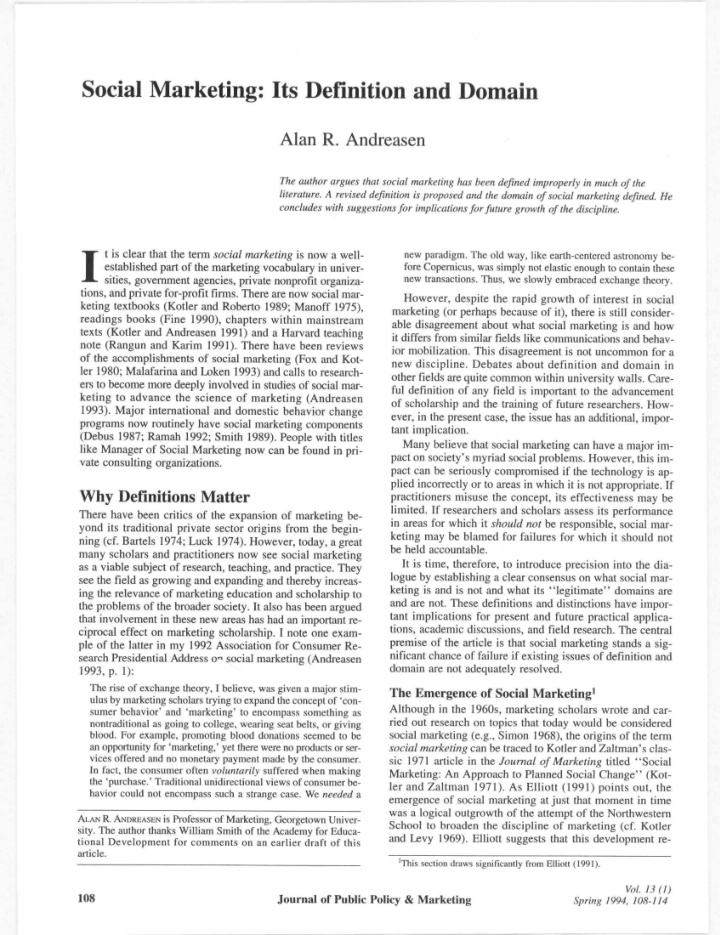



Social Marketing: Its Definition and Domain Alan R. Andreasen The author argues that social marketing has been defined improperly in much ofthe literature. A revised definition is proposed and the domain of social marketing defined. He concludes with suggestions for implications for fitture growth ofthe discipline. I t is clear that the temi social marketing is now a well- new paradigm. The old way, like earth-centered astronomy be- fore Copernicus, was simply not elastic enough to contain these established part of the marketing vocabulary in univer- new transactions. Thus, we slowly embraced exchange theory. sities, govemmetit agencies, private nonprofit organiza- tions, and private for-profit firms. There are now social mar- However, despite the rapid growth of Interest in social keting textbooks (Kotler and Roberto 1989; Manoff 1975), marketing (or perhaps because of it), there is still consider- readings books (Fine 1990), chapters within mainstream able disagreement about what social marketing is and how texts (Kotler and Andreasen 1991) and a Harvard teaching it differs from similar fields like communications and behav- note (Rangun and Karim 1991). There have been reviews ior mobilization. Tbis disagreement is not uncommon for a ofthe accomplishments of social marketing (Fox and Kot- new discipline. Debates about definition and domain in ler 1980; Malafarina and Loken 1993) and calls to research- other fields are quite common witbin university walls. Care- ers to become more deeply involved in studies of social mar- ful definition of any field is important to the advancement keting to advance the science of marketing (Andreasen of scholarship and the training of future researchers. How- 1993). Major international and domestic behavior change ever, in the present case, the issue has an additional, impor- programs now routinely have social marketing components tant implication. (Debus 1987; Ramah 1992; Smith 1989). People with titles Many believe that social marketing can have a major im- like Manager of Social Marketing now can be found in pri- pact on society's myriad social problems. However, this im- vate consulting organizations. pact can be seriously compromised if the technology is ap- plied incorrectly or to areas in which it is not appropriate. If Why Definitions Matter practitioners misuse the concept, its effectiveness may be limited. If researchers and scholars assess its performance There bave been critics of the expansion of marketing be- in areas for which it should not be responsible, social mar- yond its traditional private sector origins from the begin- keting may be blamed for failures for wbich it should not ning (cf. Bartels 1974; Luck 1974). However, today, a great be held accountable. many scholars and practitioners now see social marketing It is time, therefore, to introduce precision into the dia- as a viable subject of researcb, teaching, and practice. Tbey logue by establishing a clear consensus on what social mar- see tbe field as growing and expanding and tbereby increas- keting is and is not and what its "legitimate" domains are ing the relevance of marketing education and scholarship to and are not. These definitions and distinctions bave impor- the problems of tbe broader society, (t also has been argued tant implications for present and future practical applica- tbat involvement in these new areas has bad an important re- tions, academic discussions, and field researcb. The central ciprocal effect on marketing scholarship. T note one exam- premise of the article is that social marketing stands a sig- ple of the latter in my 1992 Association for Consumer Re- nificant chance of failure if existing issues of definition and search Presidential Address o" social marketing (Andreasen domain are not adequately resolved. 1993, p. 1): The rise of exchange theory, I believe, was given a major stim- The Emergence of Social Marketing* ulus by marketing scholars trying to expand the concept of 'con- Altbough in the 1960s, marketing scholars wrote and car- sumer behavior' and 'marketing' to encompass something as ried out research on topics tbat today would be considered nontraditional as going to college, wearing seat belts, or giving blood. For example, promoting blood donations seemed to be social marketing (e.g., Simon 1968), the origins of tbe term an opportunity for 'marketing,' yet there were no products or ser- .social marketing can be traced to Kotler and Zaltman's clas- vice.s offered and no monetary payment made by the consumer. sic 1971 article in tbe Journal of Marketing titled "Social In fact, the consumer often voluntarily suffered when making Marketing: An Approach to Planned Social Change" (Kot- the 'purchase.' Traditional unidirectional views of consumer be- ler and Zaltman 1971). As Elliott (1991) points out, tbe havior could not encompass such a strange case. We needed a emergence of social marketing at just tbat moment in time was a logical outgrowth of the attempt of tbe Northwestern ALAN R ANDREASEN is Professor of Markehng, Georgetown Univer- School to broaden tbe discipline of marketing (cf. Kotler sity. The author thanks William Smith of the Academy for Educa- and Levy 1969). Elliott suggests that tbis development re- tional Development for comments on an earlier draft of tbis article. 'This section draws significantly from Elliolt (1991). Vol. 13 (I) 108 Journa] of Public Policy & Marketing Spring 1994, 108-114
Recommend
More recommend